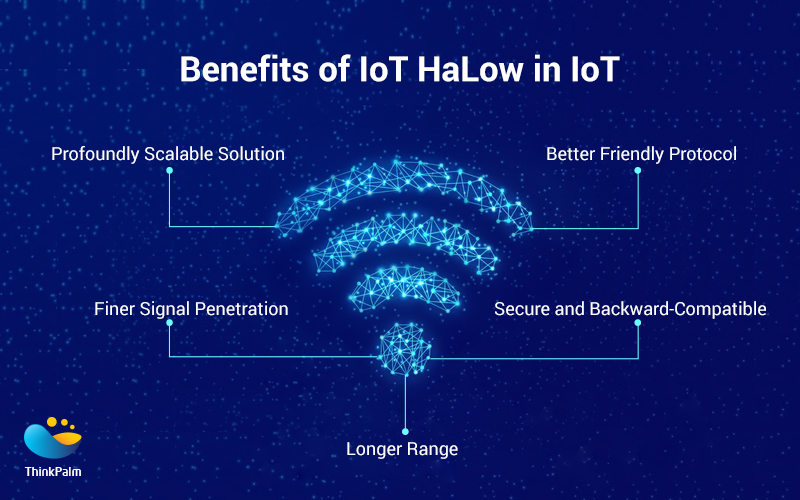Today, it is nearly impossible to think of a life without the internet. Wi-Fi has become an essential part of our day-to-day life, as we use it every day for communicating, streaming, gaming, etc. The term “Wi-Fi” represents the expanding family of 802.11 protocols that have unfolded over more than two decades. Nowadays, the accelerated utilization of the internet of things has resulted in the demand to reshape regular WiFi. The greater requirements for long-range connectivity and low-power necessities for Internet of Things (IoT) and machine-to-machine (M2M) applications are forcing the demand for a different sort of Wi-Fi optimized for the IoT. This is where Wi-Fi HaLow comes into the picture.
Wi-Fi HaLow is a more versatile alternative to Wi-Fi operating in the unlicensed sub-1-GHz spectrum. This type of Wi-Fi variant is lower-powered and longer-ranged. The Wi-Fi HaLow presents an excellent protocol option for wirelessly connected, battery-powered IoT device standards because of its different blend of energy capability, long-range connectivity, low latency, security features, HD video-quality data rates, and local IP support. Wi-Fi HaLow implements ultra-low-power wireless connectivity that combines greater figures of IoT devices at a moderate power than that of traditional Wi-Fi and also at a much longer distance. Wi-Fi HaLow also benefits a lot in the industrial IoT(IIoT), which assists in making IIoT connectivity a practical reality for many manufacturing plants, warehouses, and production lines. It also enables to enhance the number of process automation functions that can be executed wirelessly.
Also Read: Wireless Fidelity (Wi-Fi): 3 Latest Developments and Trends in WiFi
Wi-Fi HaLow is regarded as one of the best fits for IoT connectivity in the coming future. It has made it much easier for IoT devices for more reliable connectivity.

Wi-Fi HaLow renders an excellent energy capability for power-sensitive IoT devices. Several complex methods designated by IEEE 802.11ah allow HaLow devices to stay in quite low power states for an extended duration of time, preserving battery energy.
This is another reason why Wi-Fi HaLow is regarded as a good fit for IoT devices. The 802.11 model meets a remarkably extensive range of frequencies, from sub-GHz to millimeter-wave (mmWave). HaLow is the primary Wi-Fi standard to perform in the unlicensed sub-GHz band. It allows data rates ranging from hundreds of kilobits per second to tens of megabits per second and over ranges of tens of meters to more than a kilometer.
Also Read: An Introduction To IoT Architecture And Its Benefits For Enterprises!
The weaker the frequency, the greater the reach and hence, the more reliable the entrance through obstacles. Sub-GHz Wi-Fi HaLow signals can transfer through walls and other barriers more efficiently than traditional Wi-Fi.
Wi-Fi HaLow also provides a reliable yet scalable solution, and the reason to back this up is that a single Wi-Fi HaLow AP can direct up to 8,191 devices, more than 4x times as multiple devices as a traditional Wi-Fi access point. That’s an adequate capability to connect every smart door lock, modem, motorized window shade, security camera, or any other device for the foreseeable future.
Wi-Fi HaLow is a powerful, reliable wireless protocol. It sustains the most advanced Wi-Fi demands for authentication (WPA3) and AES encryption of over-the-air (OTA) traffic, with data rates that allow stable OTA firmware upgrades.
Wi-Fi has become an imperative part of our lives today. There is not a single company or an organization out there that is not Wi-Fi enabled. Enterprises and companies are trying to get their hands on the latest pieces of equipment to provide their clients their advanced services, for example, mobile app development services, IoT services, and AI services. Wi-Fi HaLow has paved the way for IoT devices for better, seamless connectivity and will continue to do so in the future.
Here at ThikPalm, we design highly interoperable and efficiently comprehensible protocols that help telecommunication needs and manage events present in the communication architectures. Come partner with us and leverage our state-of-the-art testing infrastructure and testing expertise in network topology testing and traffic analysis supports protocols for routing, MPLS, IP multicast, authentication, etc.